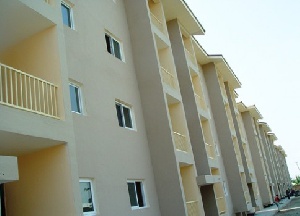Demand for housing in the Ashanti regional capital Kumasi, brought on by population growth, has led to a corresponding increase in the cost of housing, B&FT has gathered.
The population of the second largest city has increased from 1.7million in 2000 to about 2.2 million in 2015, increasing pressure on demand for accommodation and social amenities.
According to data provided by property managers in the Ashanti Region, rent in prime suburbs such as Nyiaeso, Adiambra, Ahodwo and Atasomanso ranges between GH¢400-GH¢700 per month for a decent two bedroom apartments and houses.
Additionally, renters are expected to pay between GH¢300-400 per month for two bedroom apartments and houses in Manhyia, Ahigya, and Asokwa.
The demand for housing is set to keep increasing given the City’s population dynamics and fertility rate of 2.6. Ghana Statistical Service data shows a broad base population pyramid which tapers off with a small number of elderly persons,60 years and older. This means, a large number of the population are relatively young.
The housing stock of Kumasi Metropolis during the last census in 2010 was 148,413 with average number of persons per house of about 12. The average household size of the Metropolis was 3.9.

The GSS also estimate that about 16.4 percent of all dwelling units in the Metropolis are separate houses while 54.9 percent are compound houses. Flats and apartments account for 12.9 percent of the housing stock in the city. Also, about 30.1 percent of dwelling units in the Metropolis are owned by a household member, 18.8 percent by a relative who is not a household member and 44.3 percent are owned by private individuals.
The housing stock, however, has not kept pace with the increasing demand in the city; a reflection of the broader national challenge with housing.
The current housing deficit in the country is estimated at 1.7 million units -- a figure that has been thrown into doubt by experts who contend that it’s probably more -- with an annual growth of 70,000 housing units.
With a housing deficit of 1.7 million, the country needs to provide about 170,000 homes annually for the next 10 years in order to bridge the existing gap.
Many people are homeless or live in inadequate shelters they call home in large urban centres and many commercial districts of the country.
The Ghana Real Estate Developers Association (GREDA) estimates that about 50% of Ghanaians are said to live in sub-standard housing and various unsuitable structures.
Various sources estimate that Ghana’s population could reach 32.2million people in 2020, with about 57 percent living in urban communities.
Many hard-working citizens who don’t own a house or are unable to afford decent accommodation have been let down by two main antagonists: the prevailing economic conditions and inimical housing polices (or lack thereof).
Business News of Wednesday, 12 October 2016
Source: thefinderonline.com

















